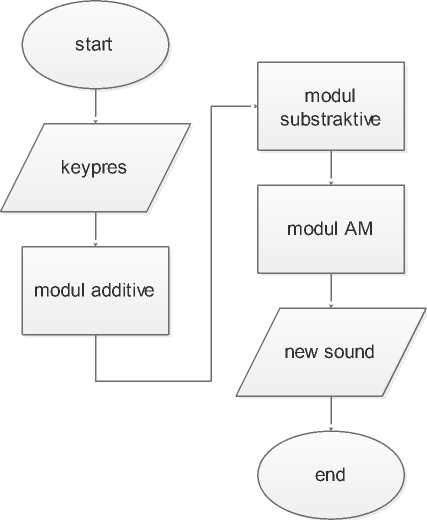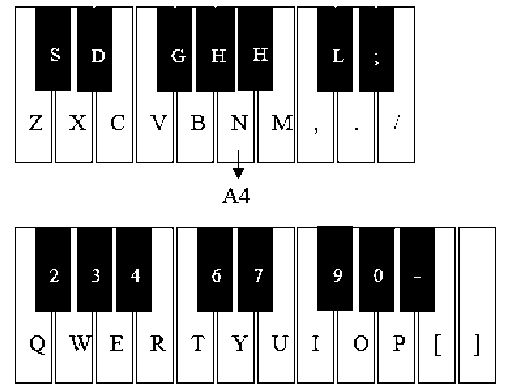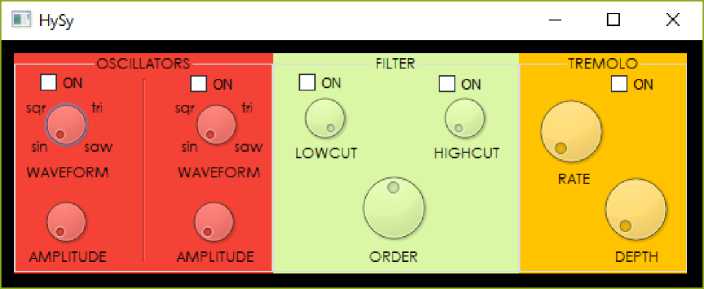Virtual Hybrid Synthesizer Application
on
p-ISSN: 2301-5373
e-ISSN: 2654-5101
Jurnal Elektronik Ilmu Komputer Udayana
Volume 8, No 3. February 2020
Virtual Hybrid Synthesizer Application
I Putu Harta Yogaa1, Gst. Ayu Vida Mastrika Giria2
aInformatics Department, Udayana University Bali, Indonesia
1Artayoa67@gmail.com 2vida.mastrika@cs.unud.ac.id
ABSTRACT
Hybrid synthesizers can be syntheses with digital or analog signals on a hardware device. In this article hybrid means make a virtual digital synthesis which combines several synthesis methods. The method used is the synthesis method of additive, substractive, and amplitude modulation (AM). Where the initial signal is an oscillator by making waves with the form Sinusoide Wave, Square Wave and Saw Tooth Wave. This virtual synthesis produces sound that has the same fundamental frequency as the fundamental frequency of notes.
Keywords: Hibrid Synthesizer, Additive, Substractive, Amplitude Modulation
-
1. Introduction
The rapid development of professional audio technology along with the increase in computer hardware has increased the popularity of home music production. Today's computers have fast processing units, extensive RAM memory, lots of hard drive space, MIDI protocol and 24bit audio interface. All of these functions make the computer a very sophisticated music production machine. All songs or even albums can be made entirely on today's laptops or even tablet computers without the lack of professional studio quality.
Virtual analog synthesis became a popular and commercial term around 1995, when Clavia introduced the Nord Lead 1 synthesizer, which was marketed as an analog-sounding digital synthesizer that did not use samples. Instead, all sounds are produced by simulating subtractive analog synthesis. Previously, the Roland D-50 synthesizer in the late 1980s worked in the same way even though it contained sample sounds. An early example of an effort to design digital synthesizers that sound analogous is Synergy [1].
Here we try to make a Virtual Hybrid Synthesizer application because it has more benefits from many sides. In terms of price (regardless of the price of computer equipment), synthesizers in the form of (digital) applications are certainly much cheaper than analog synthesizers in general which use electronic devices that can be very expensive. Then, if the complexity of the music you want to produce isn't too high then the application will be more practical than the syntesizer in physical form. In terms of affordability also this application will be more easily obtained and the latter in terms of convenience will be easier to use with a display that is easier for users to understand.
The word "hybrid" can be considered very broad in the context of sound synthesis. Hybrid can mean a combination of digital and analog elements in one hardware unit, or a combination of more than one synthesis method in one synthesizer. In our case, hybrid will be a combination of more than one method, namely the additive, substractive, and amplitude modulation (AM) synthesis methods.

Figure 1. flowchart methods
Figure 1 is the flowchart method used in the application. The application starts when the user presses keypress. Keypress represents the tone used. The tone was originally a wave. the wave will be changed using the Additive or Substractive method which will generate a new signal. The new signal will change its amplitude which affects the signal sound. The following is a complete explanation of the method used.
-
2.1 Keypress
An oscillator is an electronic circuit that generates a number of vibrations or electrical signals periodically with a constant amplitude. The resulting signal waves are in the form of Sinusoide Waves, Square Waves and Saw Tooth Waves.
The input of this program is keypres. Keypress is the key / key on the keyboard pressed by the user. Later, the oscillator will produce waves with frequency based on the keys pressed. The keypress layout on the keyboard is arranged to resemble a piano layout. Here is a comparison of the keyboard layout with the piano layout, with N being A4 (440 Hz).

Figure 2. keypress
-
2.2 Modul Additive
An additive module is a module that performs additive synthesis where two or more signals are added. The results of these additions will produce a signal that has a new timbre. Here, the generator of the signal, the oscillator, is found in the additive module. There are two oscillators to choose from, the wave type and the amplitude of each oscillator.
-
2.3 Modul Substractive
In this module there are two filters that can be activated / deactivated separately. The first filter is a lowpass filter and the second filter is a highpass filter. If both filters are activated, it will become a bandpass filter. There is also a knob to adjust the filter tilt at the cutoff frequency.
-
2.3.1 Low-pass Filter
Low-pass is a filter that allows frequencies below the frequency cut, in other words the frequency above the frequency cut decreases to a point that is no longer relevant.
-
2.3.2 High-pass Filter
High-pass is a filter that allows the frequency above the frequency cut to pass, in other words the frequency below the frequency cut decreases to a point that is no longer relevant.
-
2.3.3 Band-pass Filter
Band-pass is a filter that combines low-pass and high-pass filters.
-
2.4 Modul AM
This AM module is the last module in the chain of sound formation in this synthesizer. This module provides a tremolo effect that is an effect that gives a constant change in volume with speed and depth (the change in volume) that can be adjusted.
-
2.4.1 Envelope
Envelope is the rate of amplitude of a sound from the moment it is produced until it fades. The amplitude rate of notes is called the ADSR envelope (an acronym for the words Attack, Decay, Sustain, and Release), and has a behavior that can be applied to any sound and instrument. Descriptions of the four stages are: Attack ie the amplitude quickly reaches its highest value, Decay that is after the attack, some energy is lost and the amplitude decreases, Sustain is the amplitude that stays at a nearly constant level for a certain time interval, Release ie the amplitude decreases continuously until it runs out.
-
2.4.2 Amplitudo Modulation (AM)
Amplitude Modulation (AM) is the process of superimposing an information signal to a carrier signal in such a way that the amplitude of the carrier wave changes according to changes in the deviation (voltage) of the information signal. In this type of modulation the amplitude of the carrier signal is changed proportionally to the amplitude of the instantaneous modulation signal, while the frequency remains during the modulation process.
The following are the results of applications that have been built and run on a PC. There is no piano image to show keys that can be pressed on the keyboard keys like in general. But in terms of functionality, this application can already be used to play music with a little tweaking in this synthesizer. In terms of appearance, each control is made large and clear so as not to confuse the user. Below there is a comparison of applications that have been built with several other virtual synthesizers.

Figure 3. view synthesizer
Virtual Synthesizer can easily help many people play or create music without having to have actual analog hardware. The virtual application built here is a hybrid synthesizer. In this case, hybrid will be a combination of more than one method, namely the additive, substractive, and amplitude modulation (AM) synthesis methods.
There are three modules in this synthesizer. Each module can be activated or deactivated. If a module is deactivated, the sound / waves generated from the previous module will be skipped without being affected by the process of the deactivated module.
Applications that have been successfully built can run and function as expected. There is no piano image to show the tone or key of each key pressed by the user but will be given in the manual as in the method section above.
References
-
[1] Kaplan, S. J. “Developing a commercial digital sound synthesizer,” Computer Music Journal 5(3): 62–73, 1981.
-
[2] Russ, Martin. Sound synthesis and sampling. Routledge, 2012.
-
[3] Mengual, L..Modal synthesis of weapon sounds. MOFFAT, D., & Reiss, J. D. (2016).
-
[4] A. Farnell, "Designing Sound: Procedural Audio Research," PhD, Escola des Artes, Universidade Catolica Portuguesa, 201
360
Discussion and feedback